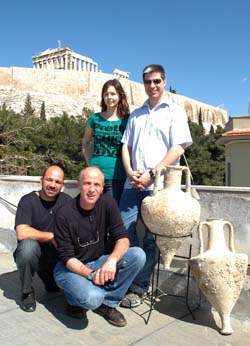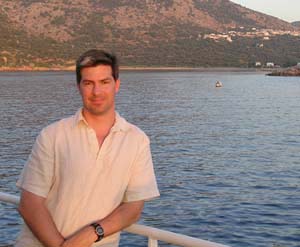 |
 |
| current issue |  | past issues |  | send a letter/news |  | address update |  | advertise |  | about us |  | alumni home |
Features
On the Track of ShipwrecksPage 2 of 5

|
Foley went on to pursue a Master of Arts degree in history at Tufts University, focused on the social and economic history of maritime America from 1580 to 1860. He then won a Rotary Foundation Ambassadorial Scholarship to attend the University of Southampton in England, where he chose the most technically intensive research track and earned a Master of Science degree in maritime archaeology.
In January 1997, Foley was hired as research assistant by David Mindell, professor of engineering systems in the Science, Technology and Society program at the Massachusetts Institute of Technology (MIT). Mindell, a historian and electrical engineer who began his career at Woods Hole, designs control, navigation and mapping systems for marine research vehicles used by Woods Hole and MIT. Foley soon joined Mindell on an expedition in the western Mediterranean Sea with a team of engineers, archaeologists and oceanographers led by Robert Ballard, who more than a decade earlier had discovered the wreck of the Titanic.
The team spent six weeks searching for and surveying shipwrecks along an ancient maritime trade route between Carthage and Rome. Aided by a U.S. Naval nuclear submarine with long-range sonar, the team quickly located eight ancient shipwrecks, its most important discovery a 2nd-century B.C. Roman sailing vessel whose remains included ceramic transport jars called amphoras that likely carried wines and oils for trade.
Returning to the Roman shipwreck on a research vessel, the team lowered Jason, a remotely operated robot equipped with Mindell's systems, via a long fiber optic tether into the water just above the site. Jason's pilot guided the robot back and forth over the wreck, in movements Foley calls "mowing the lawn," to survey the site and generate sonar and photographic images of its remains and artifacts. Using a computer on board the research vessel, Foley melded hundreds of discrete images into detailed photomosaics, which the pilot then used to guide the robot toward the artifacts and lift fragile pieces of amphoras with its mechanical arms and legs, placing them in an elevator-like device that brought them to the surface.

|
"It was the perfect introduction to all of this stuff and the most exciting thing happening in the field," says Foley. It also taught him something about international relations that has since served him well. Although Foley maintains that the research took place in international waters near Skerki Bank, an underwater feature off the coast of Sicily, the Italian government criticized the expedition and publicly denounced the researchers as "pirates." "We were completely legal and ethical, but it drove home to me that you can do everything legally, but perception is all that matters," he says.
Foley decided to pursue a Ph.D. in Mindell's interdisciplinary department and become a more integral part of the marine research projects underway through MIT and Woods Hole's Joint Program for graduate students, and to one day be in a position to shape the future of a new field of research. Shortly after beginning his doctoral work in fall 1997, Foley persuaded Mindell, now his dissertation advisor, of the need for a research program in deep-water archaeology. Although the new technologies developed by Mindell and his colleagues had made the practice of deep-water archaeology possible, no such field or research program to support it formally existed yet.
"That trip to Skerki Bank turned out to be a very important one, so Brendan was there at the very beginning of what we were doing," explains Mindell, who says Foley was accepted as a doctoral candidate at MIT as much for his impressive work on the expedition as for his dual background in archaeology and history. "It was clear from that expedition that even the people who were doing deep-water archaeology didn't really understand how a new field was created or what the basic parameters should be," he says. "Brendan persuaded me that no one else knew exactly what they were doing either, and he proceeded to work with me over the next seven years to build the world's first research program in deep-water archaeology. It's the sort of thing we're encouraged to do at MIT. It's one of those cases of one learning as much from the student as you teach the student."
Deep-water archaeology, as Mindell describes it, is an amalgamated discipline created by the fusion of traditional marine archaeology with engineering and oceanography. Foley defines it alternately as a humanities field of inquiry that employs rigorous scientific research methods. It differs from marine archaeology—research conducted by scuba divers on shallow underwater sites of up to 50 meters—in that deep-water shipwrecks are inherently closed to direct human contact, and the surveying of these sites must be done remotely, with technology tools.
Mindell established the MIT Deep Water Archaeology Research Group, or DeepArch, in 1998, to develop the methodologies, technologies and scientific skills for investigating shipwrecks in deep water. He and Foley, his close collaborator, conceived of the research group, like the new field itself, as necessarily interdisciplinary and international, requiring collaboration among scientists and humanities scholars, as well as strong partnerships with governments, research institutes and universities around the world.

|
"It didn't exist anywhere else," say Mindell of the research group, "because no one else had the ability to bridge between engineering, archaeology and oceanography."
At MIT in 1999 and 2002, DeepArch hosted the first major conferences on deep-water archaeology, drawing international participants into discussions of the field's theories and practices, as well as its ethical and legal issues. In these years, DeepArch researchers and their colleagues published papers and led or joined others' expeditions in the U.S. and abroad to test their ideas and apply their research and technologies in the field. They conducted acoustic investigations of a Civil War submarine and refined their surveying methods on an early modern wreck in the Aegean Sea and four Byzantine-era shipwrecks in the Black Sea. In short, DeepArch laid the foundation for the first ever large-scale exploration of shipwrecks on the deep ocean floor.
Page: < Previous 1 2 3 4 5 Next >
Easy to print version

